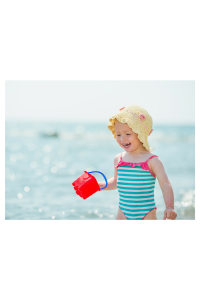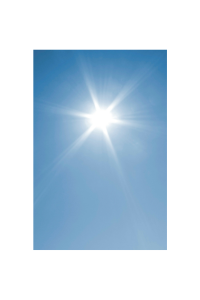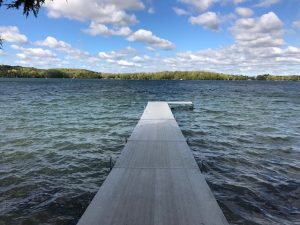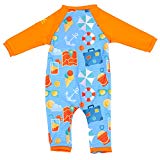
Photo: BPM, Hermosa Beach, Calif
As a new parent, you’ve got lots of roles—like chief pacifier finder, master “solid” food masher and diaper duty delegator. But guess what? You’re the sunscreen czar, too.
Are you doing enough to protect your kiddo–and yourself–from the sun’s damaging rays? How up are you on the nitty-gritty of deciphering sunscreen SPFs, picking the best sunscreen, or treating a mild sunburn? What’s a good sunscreen for babies?
Take BPM’s quiz to find out—and brush up on your sun smarts to help keep everyone’s skin healthier this summer and beyond.
Ready? Here goes:
 1. 80 percent of the harmful sun exposure occurs before age:
1. 80 percent of the harmful sun exposure occurs before age:
- 18
- 25
- 40
Answer: A. Age 18; 80 percent of harmful sun exposure occurs before then. That’s why you want to get in the habit of using sunscreen on your kiddo now.
Inside story: Skin cells are akin to old friends who like to remind you of that embarrassing thing you did way back when: They have a good memory. In fact, skin cells hold onto the damage done in youth and come back to haunt you decades later, which is how long it can take skin cancer to develop.
More aptly put: “Skin cells have a gene that can get damaged by the sun in childhood, setting the stage for cells to divide abnormally as we get older,” says David J. Leffell, MD, a Yale Dermatologic Surgery in New Haven, CT.
2. True or false: It’s safe for babies younger than 6 months to wear sunscreen.
Answer: True. The American Academy of Pediatrics (AAP) says it’s safe for infants younger than 6 months to wear minimal amounts of sunscreen on small areas such as the face and neck. But…generally, you want to avoid the need for sunscreen in babies this age. That is, it’s just better to keep a baby younger than 6 months out of the sun period—as in under the shade of a tree, umbrella, or stroller canopy.
Any amount of sun in such a young ‘un is just too risky. “Babies are more prone than adults to sunburn because their skin is young and immature,” says Erum Ilyas, MD, a member of the Society for Pediatric Dermatology. Their body’s protective tanning response isn’t developed.
“Kids can burn very quickly,” adds June Robinson, MD, research professor of dermatology at the Northwestern University Feinberg School of Medicine, in Chicago, especially under the summer’s intense rays. And, worse, you can’t necessarily tell when they’re getting fried.
Often, a sunburn doesn’t show up until that night or the next morning. And even if your child’s skin does start to look pink while he’s playing in the sun, the damage is already done.
If you can’t avoid exposing your baby to the sun, Dr. Ilyas recommends using sunscreen with the key ingredients zinc oxide and/or titanium dioxide like these. In fact, she recommends a zinc oxide and/or titanium dioxide based sunscreen for all ages, including adults.
Zinc oxide and titanium dioxide physically block the sun’s harmful ultraviolet A (UVA) and ultraviolet B (UVB) rays from penetrating your baby’s skin. On sunscreen labels, you may see them described as a “mineral blocker.” That’s a clue you’re buying a sunscreen that physically blocks the sun from penetrating the skin.
According to new Food and Drug Administration requirements, to be released in fall 2019, zinc oxide and titanium dioxide are generally recognized as safe and effective (GRASE) for use in sunscreen products. “The particle size of zinc oxide and titanium dioxide is too large for our bodies to absorb. They’re harmless to use, but the most effective ingredients in terms of physically blocking UV from affecting our skin,” Dr. Ilyas says.
3. True or False: The best sunscreen for babies with sensitive skin has zinc oxide or titanium dioxide.
Answer: True. Sunscreen with zinc oxide or titanium dioxide is the appropriate and best for babies with sensitive skin and all skin types. “When babies get rashes from sunscreen or skincare products in general, it’s often not the active ingredients that cause the problem but the inactive ingredients, such as the preservatives and the fragrance,” Dr. Illyas says.
To avoid skin irritation from sunscreen, she suggests looking for fragrance free sunscreen and sunscreen with few preservatives.
Likewise, don’t multitask. Avoid sunscreens with built-in bug repellent, which can irritate the skin.
4. Sunscreen with zinc oxide or titanium dioxide looks white and pasty on skin.
Answer: False. Both active ingredients used to apply white and pasty on the skin, but not anymore. Sunscreen products with these key ingredients are now available that apply clear. These products use a finer “micronized” version of zinc and/or titanium, which makes them invisible. And they’re still effective.
Sunscreen with zinc and/or titanium dioxide is great for the whole family, so you don’t have to look like a mime at the beach or a ghost on the golf course.
-
Which is better at protecting kids from the sun:
- Sunscreen that’s waterproof
- Sunscreen that’s sweat proof
- Sunblock
- None of the above
Answer D. None of the above. No sunscreens are “waterproof,” “sweat proof” or can qualify as “sunblock.” That’s because all sunscreens eventually wash off and sunblock overstates a sunscreen’s effectiveness. In fact, you won’t see these terms on product labels anymore; they’ve been eliminated there, but you might still see them in sunscreen ads and other places.
What you might still see on sunscreen labels is “water resistant,” which means that the sunscreen remains effective for 40 minutes or 80 minutes while swimming or sweating, based on standard testing. If your child will be sweating or swimming, definitely get a water-resistant sunscreen.
6. Which are more harmful:

- UVA rays
- UVB rays
- Both A and B.
Answer C: Both A and B. They’re equally harmful because both types can cause skin cancer and are considered carcinogens. The sun’s penetrating UVB rays also cause sunburn. UVA rays break down the skin’s collagen, leading to wrinkles.
You want to safeguard your skin and your baby’s from both types of harmful ultraviolet light so look for “broad spectrum” on the label.
7. You and the kiddos are at highest risk for a sunburn:

- at the beach or the lake
- at the pool
- on a hike in the mountains
- at the playground
Answer A, B and C. The beach, lake, the pool, and the mountains are all serious sunburn spots. In or near the water, everyone gets a double whammy of ultraviolet radiation: harmful rays from above and those reflecting off of the water. At high altitudes, the sun’s rays are also more dangerous because the rays are more concentrated. The sun is less of a threat on the playground because some rays are absorbed by the dark surface—but kids will still get burned without sunscreen.
You can also get burned through a car window or on a cloudy or hazy day if you’re not protected. “You can’t see or feel ultraviolet radiation. But it’s there and it can be powerful,” says Dr. Leffell.
8. True or False: You don’t need to reapply sunscreen after swimming or sweating if the product is “water resistant.”
Answer False. Water-resistant sunscreen isn’t 100 percent water-resistant. The pool, the ocean, sweat, even drying your child with a towel can wash or rub it off. Your best bet? “If your child is swimming or sweating, reapply your child’s water-resistant sunscreen every hour,” Dr. Ilyas says. Don’t forget to apply protection to little feet, ears and noses–three highly sensitive and commonly-burned areas on kids.
If your child isn’t sweating or swimming, you don’t have to worry so much about timing and reapplying because zinc oxide or titanium dioxide based sunscreens don’t lose their effectiveness after a few hours, like chemical sunscreens can, she says.
9.True or false: A sunscreen with a sun protection factor (SPF) of 30 protects your child twice as long as one with a SPF of 15.
Answer False. A sunscreen with an SPF of 30 blocks 96 to 97 percent of the sun’s rays, only 2 to 3 percent more than a sunscreen with a SPF of 15 does. So, a sunscreen with a higher SPF isn’t that much better. According to the FDA, products with an SPF of more than 50 haven’t been shown to provide greater protection.
Still, if your kids are going to be in the sun for more than a couple of hours, opt for a sunscreen with an SPF of 50+. “The extra 2 to 3 percent of protection can make a difference,” says Kathleen Behr, M.D., a dermatologist and skin cancer specialist in Fresno, California.
10. True or false: It takes four sunburns to increase a child’s risk of skin cancer.
Answer False. Kids who get even just two blistering sunburns may their risk of skin cancer later in life, which is one of the best reasons to protect your child’s skin from Day 1.
11. The best way to soothe a child’s mild sunburn is to:
a. apply a thin layer of petroleum jelly
b. have her take a bath, then put on moisturize
c. just leave the skin alone; it will heal faster by itself
Answer B. Bath then moisturize. Hopefully, you won’t be dealing with sunburn, but if you are, the bath will cool your child off, and a basic moisturizer helps replenish her dried-out skin. Keep your kiddo out of the sun until her sunburn is healed. If your baby gets burned, give her juice or water to replace lost fluids and call your pediatrician immediately. A severe sunburn in an infant can be dangerous.
12. True or false: Most sunscreens have a shelf life of:
A. 1 year
B. 5 years
C. depends on the brand
Answer C. It depends on the brand. Even if the product that’s been hanging around in your medicine cabinet has a later expiration date on the bottle, it’s best to replace your sunscreen every summer to be sure it’s as effective as possible for your children, recommends Patricia Witman, MD, chief of the section of dermatology at Nationwide Children’s Hospital, in Columbus, Ohio.
13. The very best way to protect your child from the sun’s burning rays is by:

- having her wear a brimmed hat and other clothing that will block out the sun
- keeping him in the shade
- using a sunscreen with zinc oxide or titanium dioxide
- All of the above
Answer 4. All of the above. “Sunscreen is only one component,” Dr. Behr says. Try to keep your child out of direct sunlight between 10 AM and 2 PM, when the sun is strongest. If this is unrealistic, have him take frequent shade breaks. At the beach and other sunny spots, make sure he wears a hat, and have him wear a shirt at least part of the day, or actual sun-protective clothing.
Think about wearing sun-protective clothing yourself too. For ideas, check out AmberNoon, a line of sun-protective clothing for women that Dr. Illyas developed.
14. It’s a good idea to apply a physical/mineral blocker sunscreen to your child:
A. 30 minutes before she goes out in the sun
B. 10 minutes before she goes out in the sun
C. Just before going outside
Answer C. Just before going outside. Sunscreens with zinc oxide or titanium dioxide aren’t like chemically-blocking sunscreens, which contain chemicals like avobenzone and oxybenzone. Sunscreen with physical blockers (aka “mineral” sunscreens, such as zinc oxide or titanium dioxide, sit on top of the skin to physically block the sun’s rays. They start working immediately. They don’t need time to sink in.
Chemical sunscreens, on the other hand, need time to penetrate the skin because that’s how they work. The skin absorbs these chemicals, which then absorb the sun’s UV.
The thing to know: “Chemical sunscreens have a limited absorption. Once they’ve met their absorbability, the sun’s rays will break through to start to affect the skin,” Dr. Ilyas says. Chemical sunscreen also need plenty of time to penetrate the skin to do their job, which is you need to apply them 30 minutes before going outside.
15. True or false: It’s okay to use an adult sunscreen on your child’s skin.
Answer True. It’s not necessary to buy one sunscreen for you and a separate one for the kids, since adult versions are rarely irritating. “I put the same sunscreen on my children that I use, unless I notice that they have a sensitivity to it,” Dr. Behr says.
It’s also fine for you to use the kids’ stuff, since it works as well as the adult version.
16. True or False: It’s fine to use the same sunscreen on your face you use for the rest of your body.
Answer True. It’s perfectly fine to apply an all-over sunscreen to your face. But let’s face it: For everyday, you might not want to. Some people like to use a different sunscreen for the face. “I use a sunscreen for the face designed for acne prone skin,” says Allison Arthur, MD, a board certified dermatologist in private practice in Orlando, Florida. “I use Elta MD, a sunscreen with ultra micronized zinc. It rubs in easily, blends in well (no white cast to the skin) and it’s very comfortable and it has a nice, light feel.”
Elta MD is available on Amazon, but not at CVS or Walgreen’s. It’s considered medical grade sunscreen, which is a little more refined than drugstore brands.
Still, it’s all about finding what you like and using it. “The best sunscreen is one you’ll wear every day,” Dr. Arthur says. For everything, even your face, consider store brand sunscreen. “My general recommendation for sunscreen is the cheaper, the better,” Dr. Ilyas says, “because my general concern is using it. If you buy expensive products, you’re more likely not to use it as much because you’re worried about cost.”
But stick with the non-spray stuff for your face and your kid’s faces. “I never recommend using spray sunscreens on the face or the neck or anywhere they could be inhaled,” Dr. Arthur says.
Fun Sun Facts
Which SPF is best? The American Academy of Dermatology recommends sunscreen with SPF 30 or higher.
Keep up the good work. As kids get older, they can apply sunscreen themselves. But a recent study in Pediatrics found that while knowledge of skin cancer increases with age, many children and adolescents aren’t bothering to use it.
Keep up the reminders and be a good role model by using sunscreen yourself every day, even when you’re just out and about. “The biggest barrier we struggle with is that people think they’re only supposed to wear sunblock at the beach or the pool,” Dr. Ilyas says. “But the sun at the beach or the pool is the is the exact same sun you’re getting when you’re driving or watching your kids play on the soccer field.”
The post contains affiliate links for products BPM buys for herself and the fam. Thanks for your support!









Leave a Reply